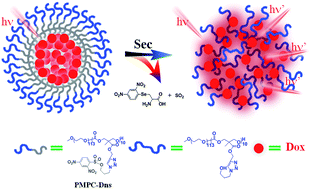In trace amounts, selenium (Se) participates in different physiological functions of the human body. Its biological significance is manifested in its presence as selenocysteine (Sec) in genetically encoded selenoproteins that are important in redox regulation, anti-inflammation, and cancer treatment. Recently, stimuli-responsive micelles were developed as biosensors, but there are no nanomicelle probes for the selective imaging of Sec under biological conditions (pH = 7.4). Herein, we report the design and preparation of a 2,4-dinitrobenzenesulfonyl-decorated block poly(carbonate) copolymer, viz. PMPC-Dns, for Sec imaging. We found that PMPC-Dns trapped with the fluorescent drug doxorubicin (DOX) selectively responds to Sec, while getting little interference from biological thiols, amines or alcohols. We applied the PMPC-Dns probe successfully to image endogenous Sec in cervical cancer tissues as well as in HeLa cells. In the course of these studies, we observed simultaneous release of the trapped DOX. Hence, besides Sec imaging, the probe can be used for controlled delivery of hydrophobic molecules for biomedical applications.

